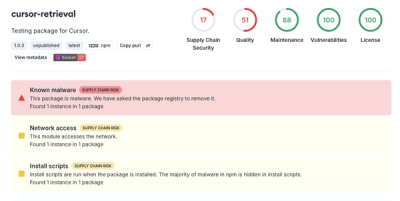
Security News
UK Officials Consider Banning Ransomware Payments from Public Entities
The UK is proposing a bold ban on ransomware payments by public entities to disrupt cybercrime, protect critical services, and lead global cybersecurity efforts.
@mux/mux-player-react
Advanced tools
An open source Mux player for React that Just Works™



<MuxPlayer/> is a Mux-flavored React video player component, built on top of our mux-player web componnent and used to play Mux Video content that Just Works.
Be sure to check out our official Mux documentation, too!
If you're using npm or yarn, install that way:
yarn add @mux/mux-player-react
or
npm i @mux/mux-player-react
Then, import the library into your application with either import or require:
import MuxPlayer from '@mux/mux-player-react';
or
const MuxPlayer = require('@mux/mux-player-react');
<MuxPlayer/> is a fully functional Video Player for the web with dirt simple integration to Mux Video and Mux Data.
<MuxPlayer/> provides a responsive UI based on player dimensions and stream type, automatic thumbnail previews and poster images, and built-in integration with Mux Data.
<MuxPlayer/> will use the optimial Hls.js settings for Mux Video so you don't have to worry about that. <MuxPlayer/> will also periodically test new versions of Hls.js and upgrade to known stable versions so you don't have to worry about upgrading to a new version of Hls.js yourself.
Under the hood, loading this library in the browser will register a custom web component for <mux-player>, but we present you with a "React-flavored" component to use it. Here's a simple example:
const MuxPlayerExample = () => {
return (
<div>
<h1>Simple MuxPlayer Example</h1>
<MuxPlayer
style={{ height: '100%', maxWidth: '100%' }}
playbackId="DS00Spx1CV902MCtPj5WknGlR102V5HFkDe"
metadata={{
video_id: 'video-id-123456',
video_title: 'Super Interesting Video',
viewer_user_id: 'user-id-bc-789',
}}
streamType="on-demand"
autoPlay
muted
/>
</div>
);
};
Providing Mux Data Metadata allows you to take full advantage of analytics and make the data more actionable, even getting metrics on how many unique viewers your content has For a detailed discussion of the available metadata fields and what they represent, check out the Mux Data docs. A few high priority keys that you'll likely want to set are:
video_id: string: Your internal ID for the video.video_title: string: Title of the video player (e.g.: 'Awesome Show: Pilot')viewer_user_id: string: An ID representing the viewer who is watching the stream. Use this to look up video views for an individual viewer. If no value is specified, a unique ID will be generated by the SDK. Note: You should not use any value that is personally identifiable on its own (such as email address, username, etc). Instead, you should supply an anonymized viewer ID which you have stored within your own system.Example:
<MuxPlayer
playback-id="DS00Spx1CV902MCtPj5WknGlR102V5HFkDe"
metadata={{
video_id: 'video-id-123456',
video_title: 'Super Interesting Video',
viewer_user_id: 'user-id-bc-789',
}}
/>
Enable the Google Cast button in the controlbar by dropping in the <script> tag below in the <head> of your webpage.
<script defer src="https://www.gstatic.com/cv/js/sender/v1/cast_sender.js?loadCastFramework=1"></script>
Using JSON Web Tokens allows you to secure your media content from public playback, and Mux Video provides a way to do set this up for your assets. To apply these tokens in <MuxPlayer/>, you can use the tokens property. <MuxPlayer/> will automatically generate appropriate URLs for each asset for any provided tokens. The possible tokens are playback (for the video asset/playback-id), thumbnail (for the poster image), and storyboard (for the seek preview thumbnail images).
Example:
<MuxPlayer
playback-id="g65IqSFtWdpGR100c2W8VUHrfIVWTNRen"
tokens={{
playback:
'eyJhbGciOiJSUzI1NiIsInR5cCI6IkpXVCIsImtpZCI6Ik96VU90ek1nUWhPbkk2MDJ6SlFQbU52THR4MDBnSjJqTlBxN0tTTzAxQlozelEifQ.eyJleHAiOjE2NDY0Mzg5NjEsImF1ZCI6InYiLCJzdWIiOiJiemVVNWZSQTQ3UzAxS0R6ck9iWWlpWnZ6ajAwajVFMDBkQ1ZidDNvUnptZkYwMCJ9.hWrdcJDa8FJCfVFP19oJ-9FSEVk9eB6DTOCRrucnzsrtUoZbb1OFe7swpQ38Fp3hZNNIt7-LWjdOl90TF4ucu7mhu42qyk3_i054RtmEZyQaj5Qjm3_H4sa2jLO-0QNSnOfp1A9x-fI8M_giGLg-byJPuu_eUqu1MW9bILLly_9gq8m0cNKghUa9xTMJgFmaya4XYudy5Mt2Fu72MiS3csUP3xhKlONVnGHlMRqB-dBVOgAJrayeUquAhaNY346oFBUWVM-EcAZ9G2ARtPakfy4Wpv5BsRKEGtR81P-k7EW8g27U0FKLlrvLkUz3Z-JYu53CRcJUvjkC9sDMrZLcTA',
thumbnail:
'eyJhbGciOiJSUzI1NiIsInR5cCI6IkpXVCIsImtpZCI6Ik96VU90ek1nUWhPbkk2MDJ6SlFQbU52THR4MDBnSjJqTlBxN0tTTzAxQlozelEifQ.eyJleHAiOjE2NDY0OTMzMTksImF1ZCI6InQiLCJzdWIiOiJiemVVNWZSQTQ3UzAxS0R6ck9iWWlpWnZ6ajAwajVFMDBkQ1ZidDNvUnptZkYwMCJ9.hNBRo1-XDTT1CJMOxf90-8JPJzAygwm-3pVNBj31I7DEukSVRKVgUuhquEJbYXx1xg27xRMu8OVQxVob6jWHdjSwTyygAY040bqdyDxLsRtkDcVxwZ78iiZwtA1eTkxxY-410Ma3HbhNsG0Qjo5AWX46IhD9ARKHL-MPGaKda7FSx8J8jxa3hQ8_M1AKMsx7PrgJYOtW6n0mvkupEAFYRJlqIbkERSBeWChdrjCLYAcXRar5nfdNWlWST2pfllqz8pfJSTWjQRumTonC5BGB89jZUimHnuzkRXm_LeGyXbfZmBKb4d0j9YyGVnTPePqyVPsAQ-bzcfFDU0L67GDgyw',
storyboard:
'eyJhbGciOiJSUzI1NiIsInR5cCI6IkpXVCIsImtpZCI6Ik96VU90ek1nUWhPbkk2MDJ6SlFQbU52THR4MDBnSjJqTlBxN0tTTzAxQlozelEifQ.eyJleHAiOjE2NDY0OTM0OTgsImF1ZCI6InMiLCJzdWIiOiJiemVVNWZSQTQ3UzAxS0R6ck9iWWlpWnZ6ajAwajVFMDBkQ1ZidDNvUnptZkYwMCJ9.PKEybohVK0JyJGX_3iubRnHZx1ve5OmPmyfZdaKb17N2wVMQCYNltTc-gCUTU7EIKGeTtVOIITCSsIeTgXcI667B2GWJ5juDIErz1h-NQsPIfB-FsUeuWx2rYOap4G3FdwEIjaGc29HPncw-mG0JLcqkMB7jtDxjBY_-YlpjFYJF_z7r-1yIJM7mF3rl8YqeWstojC8oh2Iv2VRkuTyPE31QVI6fQcet5PIRWHudUIGWcNiWM56vwZskJ6qod8UvYpha7K5rhshh0Xdhnvq3Y9b6PXl3fy6VKCZIyszlPVje0IR2bR9iHDXnGbawivUsI65IDm-ZEoJrOzmZctMWAQ',
}}
/>
By default <MuxPlayer/> will try to use native playback via the underlying <video/> tag whenever possible. However, it can also instead use an in-code player as long as the browser supports Media Source Extensions. This includes MSE in Mac OS Safari.
If you prefer to use the in-code MSE-based engine (currently hls.js) whenever possible, then simply set the preferMse prop.
Example:
<MuxPlayer
playback-id="DS00Spx1CV902MCtPj5WknGlR102V5HFkDe"
metadata={{
video_id: 'video-id-123456',
video_title: 'Super Interesting Video',
viewer_user_id: 'user-id-bc-789',
}}
preferMse
/>
| Prop | Type | Description | Default |
|---|---|---|---|
playbackId | string | The playback ID for your Mux Asset or Mux Live Stream. This will also be used for automatically assigning a poster image and (thumbnail previews)[https://docs.mux.com/guides/video/create-timeline-hover-previews]. For more, check out the Mux Docs. | N/A |
envKey | string | Your Mux Data environment key. Note that this is different than your API Key. Get your env key from the "Mux Data" part of your Mux Environments Dashboard. If undefined, the environment will be inferred based on your Mux Video asset. | undefined |
streamType | "on-demand" | "live" | "ll-live" |"live:dvr" | "ll-live:dvr" | The type of stream associated with your Mux Asset. Used to determine what UI/controls to show and what optimizations to make for playback. | "on-demand" |
audio | boolean | Indicate that you want an "audio only" UI/chrome. This may be used for audio-only assets or audio+video assets. | false |
metadata | object* | An object for configuring any metadata you'd like to send to Mux Data. For more, see the Metadata section, below. | N/A |
tokens | object* | An object for configuring any tokens for your assets if you're using Signed URLs. For more, see the Tokens section, below. | N/A |
debug | boolean | Enables debug mode for the underlying playback engine (currently hls.js) and mux-embed, providing additional information in the console. | false |
startTime | number (seconds) | Specify where in the media's timeline you want playback to start. | 0 |
thumbnailTime | number (seconds) | Offset for the poster image you want to show before loading media. If no thumbnailTime is specified, startTime will be used by default. NOTE: This feature currently cannot be used with tokens.thumbnail. | 0 |
preferMse | boolean | Use the underlying playback engine (currently hls.js), even if native playback is supported (e.g. in Safari). For more, see the section on preferMse | false |
defaultHiddenCaptions | boolean | Hide captions by default instead of showing them on initial load (when available) | false |
forwardSeekOffset | number (seconds) | Offset applied to the forward seek button | 10 |
backwardSeekOffset | number (seconds) | Offset applied to the backward seek button | 10 |
primaryColor | (Any valid CSS color style) | The primary color used by the player | N/A |
secondaryColor | (Any valid CSS color style) | The secondary color used by the player | N/A |
currentTime | number (seconds) | Sets the current time of the media | N/A |
volume | number (0-1) | Sets the volume of the player from 0 to 1. | Varies |
muted | boolean | Toggles the muted state of the player. | Varies |
paused | boolean | Toggles the paused state of the player | N/A |
autoPlay | boolean | Toggles whether or not media should auto-play when initially loaded | N/A |
playbackRate | number | Applies a multiplier to the media's playback rate, either speeding it up or slowing it down. | 1 |
loop | boolean | Automatically loop playback of your media when it finishes. | false |
nohotkeys | boolean | Toggles keyboard shortcut (hot keys) support when focus in inside the player. | false |
playsInline | boolean | Set to assert that media should be played inline. Useful for mobile playback cases. | false |
crossOrigin | string | Establishes various CORS policies. For more details, see MDN | N/A |
poster | string (URL) | Assigns a poster image URL. Will use the automatically generated poster based on your playback-id by default. | Derived |
beaconCollectionDomain | string (Domain name) | Assigns a custom domain to be used for Mux Data collection. | N/A |
customDomain | string (Domain name) | Assigns a custom domain to be used for Mux Video. Will use the standard mux.com domain with your playback-id for poster, video, and thumbnail URLs by default. | N/A |
<MuxPlayer/> has a number of callbacks associated with events for media loading, playback, and the player itself. For example, a callback for 'loadstart event isonLoadStart`. See mux-player's document for detail of events.
FAQs
An open source Mux player for React that Just Works™
The npm package @mux/mux-player-react receives a total of 103,410 weekly downloads. As such, @mux/mux-player-react popularity was classified as popular.
We found that @mux/mux-player-react demonstrated a healthy version release cadence and project activity because the last version was released less than a year ago. It has 0 open source maintainers collaborating on the project.
Did you know?

Socket for GitHub automatically highlights issues in each pull request and monitors the health of all your open source dependencies. Discover the contents of your packages and block harmful activity before you install or update your dependencies.

Security News
The UK is proposing a bold ban on ransomware payments by public entities to disrupt cybercrime, protect critical services, and lead global cybersecurity efforts.

Security News
Snyk's use of malicious npm packages for research raises ethical concerns, highlighting risks in public deployment, data exfiltration, and unauthorized testing.

Research
Security News
Socket researchers found several malicious npm packages typosquatting Chalk and Chokidar, targeting Node.js developers with kill switches and data theft.